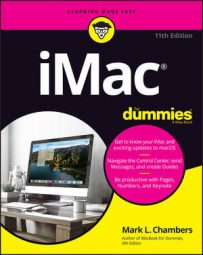- Setup provides Mojave your personal information.
Your iMac ships with a bathtub full of applications, and many of those use your personal data (like your address and telephone number) to automatically fill out your documents.
Apple has recently strengthened its efforts to guard your privacy online. If personal stored information starts you worrying about identity theft, I congratulate you. If you’re using your common sense, it should. However, Apple doesn’t disseminate this information anywhere else, and the applications that use your personal data won’t send it anywhere, either. And the Safari web browser fills out forms on a web page automatically only if you give your permission — and security-conscious iMac owners like me prefer to enter things manually.
- Setup configures your language and keyboard choices.
macOS Mojave is a truly international operating system, so Setup offers you a chance to configure your iMac to use a specific language and keyboard layout.
- Setup configures your email accounts within Apple Mail.
If you already have an email account set up with your Internet service provider (ISP), keep that email account information handy to answer these questions. (The list should include the incoming POP3/IMAP and outgoing SMTP mail servers you’ll be using, your email address, and your login name and password. Don’t worry about those crazy acronyms, though, because your ISP will know exactly what you mean when you ask for this information.) Mojave can even automatically configure many email accounts for you — including web-based services such as Google Mail, Yahoo! Mail, and AOL Mail — if you supply your account ID and password. Sweet.
- Setup allows you to sign up for an iCloud ID and Apple’s iCloud service.
iCloud makes it easy to share data automatically between your iMac and devices like an iPhone or iPad, along with Apple email accounts (through both web mail and the Apple Mail application). Create your iCloud ID (also often called an Apple ID), sign up for iCloud, and take the opportunity to feel smug about owning an Apple computer.
- Setup sends your registration information to Apple.
As a proud owner of an iMac, take advantage of the year of hardware warranty support and the free 90 days of telephone support. You have to register to use ’em, but rest assured that all this info is confidential.
- Setup launches Migration Assistant.
This assistant guides you through the process of migrating (an engineer’s term for copying) your existing user data from your old Mac or PC to your new iMac. Naturally, if your iMac is your first computer, you can skip this step with a song in your heart!

